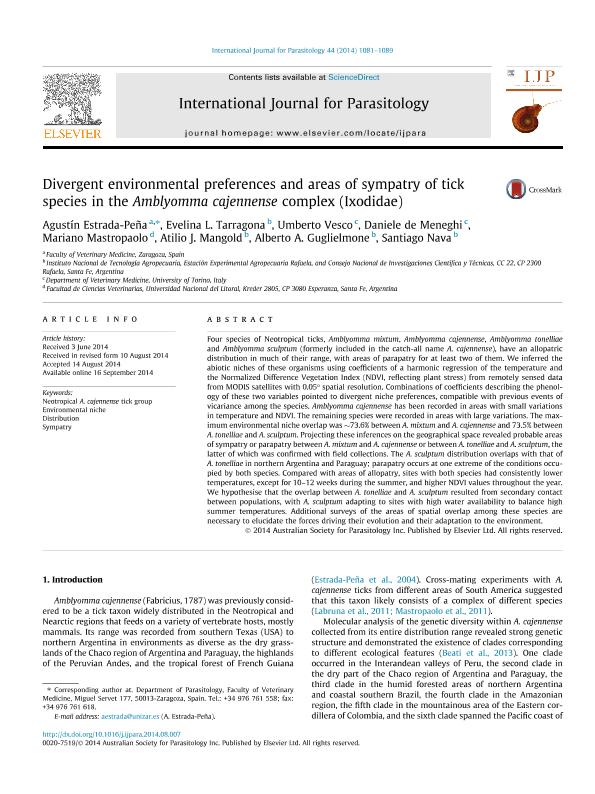Mostrar el registro sencillo del ítem
dc.contributor.author
Estrada Peña, Agustín
dc.contributor.author
Tarragona, Evelina Luisa

dc.contributor.author
Vesco, Umberto
dc.contributor.author
De Meneghi, Daniele
dc.contributor.author
Mastropaolo, Mariano

dc.contributor.author
Mangold, Atilio Jose

dc.contributor.author
Guglielmone, Alberto Alejandro

dc.contributor.author
Nava, Santiago

dc.date.available
2017-12-18T18:01:00Z
dc.date.issued
2014-09
dc.identifier.citation
Nava, Santiago; Guglielmone, Alberto Alejandro; Mangold, Atilio Jose; Mastropaolo, Mariano; De Meneghi, Daniele; Vesco, Umberto; et al.; Divergent environmental preferences and areas of sympatry of tick species in the Amblyomma cajennense complex (Ixodidae); Elsevier; International Journal for Parasitology; 44; 14; 9-2014; 1081-1089
dc.identifier.issn
0020-7519
dc.identifier.uri
http://hdl.handle.net/11336/30899
dc.description.abstract
Four species of Neotropical ticks, Amblyomma mixtum, Amblyomma cajennense, Amblyomma tonelliae and Amblyomma sculptum (formerly included in the catch-all name A. cajennense), have an allopatric distribution in much of their range, with areas of parapatry for at least two of them. We inferred the abiotic niches of these organisms using coefficients of a harmonic regression of the temperature and the Normalized Difference Vegetation Index (NDVI, reflecting plant stress) from remotely sensed data from MODIS satellites with 0.05° spatial resolution. Combinations of coefficients describing the phenology of these two variables pointed to divergent niche preferences, compatible with previous events of vicariance among the species. Amblyomma cajennense has been recorded in areas with small variations in temperature and NDVI. The remaining species were recorded in areas with large variations. The maximum environmental niche overlap was ∼73.6% between A. mixtum and A. cajennense and 73.5% between A. tonelliae and A. sculptum. Projecting these inferences on the geographical space revealed probable areas of sympatry or parapatry between A. mixtum and A. cajennense or between A. tonelliae and A. sculptum, the latter of which was confirmed with field collections. The A. sculptum distribution overlaps with that of A. tonelliae in northern Argentina and Paraguay; parapatry occurs at one extreme of the conditions occupied by both species. Compared with areas of allopatry, sites with both species had consistently lower temperatures, except for 10–12 weeks during the summer, and higher NDVI values throughout the year. We hypothesise that the overlap between A. tonelliae and A. sculptum resulted from secondary contact between populations, with A. sculptum adapting to sites with high water availability to balance high summer temperatures. Additional surveys of the areas of spatial overlap among these species are necessary to elucidate the forces driving their evolution and their adaptation to the environment.
dc.format
application/pdf
dc.language.iso
eng
dc.publisher
Elsevier

dc.rights
info:eu-repo/semantics/openAccess
dc.rights.uri
https://creativecommons.org/licenses/by-nc-nd/2.5/ar/
dc.subject
Neotropical A. Cajennense Tick Group
dc.subject
Environmental Niche
dc.subject
Distribution
dc.subject
Sympatry
dc.subject.classification
Geociencias multidisciplinaria

dc.subject.classification
Ciencias de la Tierra y relacionadas con el Medio Ambiente

dc.subject.classification
CIENCIAS NATURALES Y EXACTAS

dc.title
Divergent environmental preferences and areas of sympatry of tick species in the Amblyomma cajennense complex (Ixodidae)
dc.type
info:eu-repo/semantics/article
dc.type
info:ar-repo/semantics/artículo
dc.type
info:eu-repo/semantics/publishedVersion
dc.date.updated
2017-12-18T15:09:03Z
dc.journal.volume
44
dc.journal.number
14
dc.journal.pagination
1081-1089
dc.journal.pais
Países Bajos

dc.journal.ciudad
Ámsterdam
dc.description.fil
Fil: Estrada Peña, Agustín. Universidad de Zaragoza; España
dc.description.fil
Fil: Tarragona, Evelina Luisa. Instituto Nacional de Tecnología Agropecuaria. Centro Regional Santa Fe. Estación Experimental Agropecuaria Rafaela; Argentina. Consejo Nacional de Investigaciones Científicas y Técnicas. Centro Científico Tecnológico Conicet - Santa Fe; Argentina
dc.description.fil
Fil: Vesco, Umberto. Università di Torino; Italia
dc.description.fil
Fil: De Meneghi, Daniele. Università di Torino; Italia
dc.description.fil
Fil: Mastropaolo, Mariano. Universidad Nacional del Litoral. Facultad de Ciencias Veterinarias; Argentina. Consejo Nacional de Investigaciones Científicas y Técnicas. Centro Científico Tecnológico Conicet - Santa Fe; Argentina
dc.description.fil
Fil: Mangold, Atilio Jose. Instituto Nacional de Tecnología Agropecuaria. Centro Regional Santa Fe. Estación Experimental Agropecuaria Rafaela; Argentina. Consejo Nacional de Investigaciones Científicas y Técnicas. Centro Científico Tecnológico Conicet - Santa Fe; Argentina
dc.description.fil
Fil: Guglielmone, Alberto Alejandro. Instituto Nacional de Tecnología Agropecuaria. Centro Regional Santa Fe. Estación Experimental Agropecuaria Rafaela; Argentina. Consejo Nacional de Investigaciones Científicas y Técnicas. Centro Científico Tecnológico Conicet - Santa Fe; Argentina
dc.description.fil
Fil: Nava, Santiago. Consejo Nacional de Investigaciones Científicas y Técnicas. Centro Científico Tecnológico Conicet - Santa Fe; Argentina. Instituto Nacional de Tecnología Agropecuaria. Centro Regional Santa Fe. Estación Experimental Agropecuaria Rafaela; Argentina
dc.journal.title
International Journal for Parasitology

dc.relation.alternativeid
info:eu-repo/semantics/altIdentifier/doi/http://dx.doi.org/10.1016/j.ijpara.2014.08.007
dc.relation.alternativeid
info:eu-repo/semantics/altIdentifier/url/http://www.sciencedirect.com/science/article/pii/S002075191400229X
Archivos asociados
